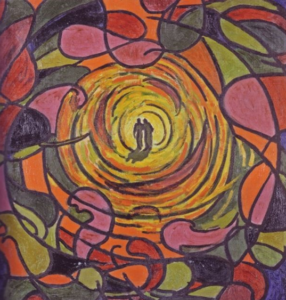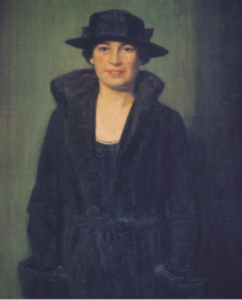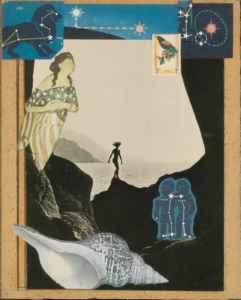VISUAL ARTS TIMELINE
1911 (March 13): Lafayette Ron Hubbard was born in Tilden, Nebraska.
1946 (March 14): Claude Sandoz was born in Zurich, Switzerland.
1948 (October 8): Gottfried Helnwein was born in Vienna, Austria.
1950 (May 9): Hubbard published Dianetics: The Modern Science of Mental Health.
1951 (August 1): Hubbard published Science of Survival, which included a section about aesthetics and the visual arts.
1953 (November 12): Carl-W. Röhrig was born in Munich, Germany.
1965 (August 30): Hubbard published his first technical bulletin of the “Art” series.
1977 (September 26): Hubbard published his technical bulletin on “Art and Communication.”
1984 (February 26): Hubbard published his technical bulletins on “Colors,” and on “Art and Integration,” where he presented his theory of the mood lines.
1986 (January 24): Hubbard died in Creston, California.
1991: The posthumous book Art, collecting Hubbard’s technical bulletins on the arts, was published.
2013 (July 24-October 13): A retrospective on the art of Helnwein at the Albertina Museum in Vienna attracted 250,000 visitors.
2013 (October 6): The renovated Flag Building of the Church of Scientology was dedicated in Clearwater, Florida. It includes sixty-two sculptures illustrating the basic concepts of Scientology.
VISUAL ARTS TEACHINGS/DOCTRINES
Lafayette Ron Hubbard (1911-1986) [Image at right] founded Dianetics and Scientology,  which represent two distinct phases of his thought. Dianetics, first presented by Hubbard in 1950, deals with the mind, and studies how it receives and stores images. Scientology focuses on the entity who looks at the images stored in the mind. Mind for Scientology has three main parts. The analytical mind observes and remembers data, stores their pictures as mental images, and uses them to take decisions and promote survival. The reactive mind records mental images at times of unconsciousness, incidents, or pain, and stores them as “engrams.” They are awakened and reactivated when similar circumstances occur, creating all sort of problems. The somatic mind, directed by the analytical or reactive mind, translates their inputs and messages on the physical level. Dianetics aims at freeing humans from engrams, helping them achieving the status of “clear.”
which represent two distinct phases of his thought. Dianetics, first presented by Hubbard in 1950, deals with the mind, and studies how it receives and stores images. Scientology focuses on the entity who looks at the images stored in the mind. Mind for Scientology has three main parts. The analytical mind observes and remembers data, stores their pictures as mental images, and uses them to take decisions and promote survival. The reactive mind records mental images at times of unconsciousness, incidents, or pain, and stores them as “engrams.” They are awakened and reactivated when similar circumstances occur, creating all sort of problems. The somatic mind, directed by the analytical or reactive mind, translates their inputs and messages on the physical level. Dianetics aims at freeing humans from engrams, helping them achieving the status of “clear.”
Dianetics, however, left open the question of who, exactly, is the subject continuously observing the images stored in the mind. To answer this question, Hubbard introduced Scientology and moved from psychology to metaphysics and religion. At the core of Scientology’s worldview, there is a gnostic narrative. In the beginning, there were the “thetans,” pure spirits who created MEST (matter, energy, space, and time), largely for their own pleasure. Unfortunately, incarnating and reincarnating in human bodies, the thetans came to forget that they had created the world, and believed that they were the effect rather than the cause of physical universe. Their level of “theta,” i.e. of creative energy, gradually decreased and, as they kept incarnating as humans, the part of mind known as the reactive mind took over.
The more the thetan believes itself to be the effect, rather than the cause, of the physical universe, the more the reactive mind exerts its negative effects, and the person is in a state of “aberration.” This affects the Tone Scale, showing the emotional tones a person can experience, and the levels of ARC (Affinity – Reality – Communication). Affinity is the positive emotional relationship we establish with others. Reality is the agreement we reach with others about how things are. Communication is the most important part of the triangle: through it, we socially construct reality and, once reality is consensually shared, we are able to generate affinity.
Hubbard was familiar with the artistic milieus as a successful writer of fiction. However, he struggled for years on how to integrate an aesthetic and a theory of the arts into his system. 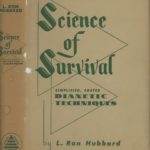 In 1951, Hubbard wrote that “there is yet to appear a good definition for aesthetics and art” (Hubbard 1976a:129). In the same year, he dealt with the argument in Science of Survival, one of his most important theoretical books. [Image at right] He returned often to the arts, particularly in seventeen articles included in technical bulletins he published from 1965 to 1984, which formed the backbone of the 1991 book Art, published by Scientology after his death (Hubbard 1991).
In 1951, Hubbard wrote that “there is yet to appear a good definition for aesthetics and art” (Hubbard 1976a:129). In the same year, he dealt with the argument in Science of Survival, one of his most important theoretical books. [Image at right] He returned often to the arts, particularly in seventeen articles included in technical bulletins he published from 1965 to 1984, which formed the backbone of the 1991 book Art, published by Scientology after his death (Hubbard 1991).
In Science of Survival, Hubbard explained that “many more mind levels apparently exist above the analytical level.” Probably “immediately above” the analytical mind, something called the “aesthetic mind” exists. Aesthetics and the aesthetic mind, Hubbard admitted, “are both highly nebulous” subjects. In general, the aesthetic mind is the mind that “deals with the nebulous field of art and creation.” And “the aesthetics have very much to do with the tone scale” (Hubbard 1951:234-36).
One might expect that the aesthetic mind would be incapable of functioning until most engrams have been eliminated and the state of clear has been reached. However, Hubbard claimed that it is not so. “It is a strange thing, he wrote, that the shut-down of the analytical mind and the aberration of the reactive mind may still leave in fairly good working order the aesthetic mind.” “The aesthetic mind is not much influenced by the position on the tone scale,” although “it evidently has to employ the analytical, reactive, and somatic minds in the creation of art and art forms” (Hubbard 1951:234).
Being “a person of great theta,” as artists often are, is also a mixed blessing. Hubbard explains that “a person of great theta endowment picks up more numerous and heavier locks and secondaries than persons of smaller endowment” (Hubbard 1951:235). Locks and secondaries are mental image pictures in which we are reminded of engrams. They would not exist without the engrams, but they may be very disturbing.
Hubbard claimed that, even before Scientology explained these phenomena, they were obvious enough to be noticed but were often misinterpreted. Many believed that it was normal, if not “absolutely necessary,” for an artist to be “neurotic.” “Lacking the ability to do anything about neurosis, like Aesop’s fox who had no tail and tried to persuade the other foxes to cut theirs off, frustrated mental pundits glorified what they could not prevent or cure.” The dysfunctional artist was hailed as a counter-cultural hero. Being “crazy” was regarded as typical of the good artist (Hubbard 1951:235).
Not so, Hubbard argued. Going down the tone scale is not good for anybody, and is not good for artists either. It is a dangerous misconception, according to Hubbard, to believe that “when an artist becomes less neurotic, he becomes less able.” Regrettably, our world has programmed the artists by widely inculcating these false ideas. The consequence is that many artists “seek to act in their private and public lives in an intensely aberrated fashion in order to prove that they are artists” (Hubbard 1951:238). Scientology, Hubbard promised, may “take a currently successful but heavily aberrated artist and (…) bring him [sic] up the tone scale” (Hubbard 1951:235). Not only will the artist be happier as a human being, he or she will also become a better artist.
Hubbard’s vision of the arts, as proposed in Science of Survival, is also crucial for Scientology’s social program. “The artist, Hubbard wrote, has an enormous role in the enhancement of today’s and the creation of tomorrow’s reality.” In fact, art operates “in advance of science” and “the elevation of a culture can be measured directly by the numbers of its people working in the field of aesthetics.” “A culture is only as great as its dreams, and its dreams are dreamed by artists” (Hubbard 1951:237-39).
Totalitarian states, Hubbard added, are the enemies of the artists, while pretending to be their friends, as they try to control them through state subsidies. Democratic governments, in principle, should not have these problems, but they run, according to Hubbard, a different risk. They “are prone to overlook the role of the artist in the society.” In the United States, he exemplified, as soon as artistic success is achieved, excessive taxes discourage the artist from further production. Hubbard proposed a tax reform with incentives for the artists. The reasons for this proposed reform were not merely economic, and were connected to Hubbard’s key idea that the prosperity of a society depends from the amount of circulating theta. Without enough theta, the reactive mind would dominate culture itself. “The artist injects the theta into the culture, and without that theta the culture becomes reactive” (Hubbard 1951:237-39).
Science of Survival also presents Hubbard’s view of the history of Western art. “In the early days of Rome, art was fairly good.” Christianity revolted against the Romans, and had one good reason for its revolt, “Roman disregard for human life.” However, those who revolt always run the risk of being dominated by the reactive mind. It thus happened, Hubbard believed, that Christianity fell into a “reactive computation” and came to regard everything Roman as negative, including the art. Happily, “the Catholic Church recovered early and began to appreciate the artist.” However, the old anti-Roman and, consequently, anti-artistic prejudice resurfaced with Protestantism and eventually came to the United States. “Puritanism and Calvinism,” according to Hubbard, “revolted against pleasure, against beauty, against cleanliness, and against many other desirable things” (Hubbard 1951:238).
The next step was a revolt against the revolt. In modern times, artists revolted against the Protestant and Puritan revolt against the classics and the arts. The problem was that, again, the reactive mind took over, and artists renounced everything Protestant, if not everything Christian, including morality. Being a good artist came to be “commonly identified with being loose-moraled, wicked, idle and drunken, and the artist, to be recognized, tried to live up to this role” (Hubbard 1951:238-39). This had a direct and negative impact on society. “When the level of existence of the artist becomes impure, so becomes impure the art itself, to the deterioration of the society. It is a dying society indeed into which can penetrate totalitarianism” (Hubbard 1951:239).
Hubbard concluded his discussion of aesthetics in Science of Survival noting that “there may be many levels of mind above the aesthetic mind” but we do know a lot about them. Therefore, “no attempt to classify any level of mind alertness above the level of the aesthetic mind will be made beyond stating that these mind levels more and more seem to approach an omniscient status” (Hubbard 1951:240). He mentioned, however, among the possible superior levels “a free theta mind, if such things exist” (Hubbard 1951:25). This notion would become central for the subsequent development in Scientology of the notion of “operating thetan,” a state where the thetan finally recovers his native abilities.
Hubbard continued his study of art after Science of Survival through writings that later would be collected 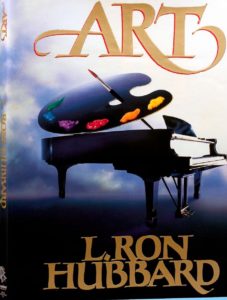 in his posthumously published book Art (Hubbard 1991). [Image at right] On August 30, 1965, he issued a technical bulletin that was quite important for his theory of art (Hubbard 1976b:83-85). Hubbard explained that it was now fifteen years since he had started considering how to “codify” knowledge about art and announced that “this [the “codification” of aesthetic theory] has now been done” (Hubbard 1976b:83).
in his posthumously published book Art (Hubbard 1991). [Image at right] On August 30, 1965, he issued a technical bulletin that was quite important for his theory of art (Hubbard 1976b:83-85). Hubbard explained that it was now fifteen years since he had started considering how to “codify” knowledge about art and announced that “this [the “codification” of aesthetic theory] has now been done” (Hubbard 1976b:83).
At first, art “seemed to stand outside the field of Dianetics and Scientology.” Hubbard, however, was not persuaded by this conclusion and eventually “made a breakthrough.” He realized that art and communication are closely connected. In fact, “ART is a word which summarizes THE QUALITY OF COMMUNICATION.” (Hubbard 1976b:83, capitals in original). Scientology had already elaborated certain “laws” about communication. Now, they should be applied to the arts.
In 1965, Hubbard was ready to propose three axioms about art. The first was that “too much originality throws the audience into unfamiliarity and therefore disagreement.” Communication, in fact, includes “duplication.” If the audience is totally unable to replicate the experience, it would not understand nor appreciate the work of art. The second axiom taught that “TECHNIQUE should not rise above the level of workability for the purpose of communication.” The third maintained that “PERFECTION cannot be attained at the expense of communication” (Hubbard 1976b:83, capitals in original).
Hubbard believed that his approach to aesthetics was new with respect to both classic and contemporary theories of art. The latter emphasized “originality,” to the point that audiences were often surprised by the artists – but, Hubbard maintained, not persuaded. The former sought perfection through technique. But, Hubbard insisted, “one should primarily seek communication with it [art] and then perfect it as far as reasonable” (Hubbard 1976b:84). Often, the artist should be prepared to lower the level of perfection to allow communication to flow.
“Art for art’s sake”, Hubbard argues, always failed because it was “attempted perfection without communicating.” We become artists when we learn how to communicate. Except in very rare cases, this does not come naturally nor is achieved overnight. Normally, one becomes an artist gradually, reflecting on past failures to communicate. These failures are, in fact, engrams, and artists should be “rehabilitated” through Dianetics just as anybody else, yet considering that they have specific engrams of their own. In fact, “due to the nature of the Reactive Mind, full rehabilitation [of the artists] is achieved only through releasing and clearing.” (Hubbard 1976b:83-85)
When the thetan understands himself as the cause rather than the effect of the physical reality, he (the thetan is always referred to by Hubbard as male, although women are incarnated thetans 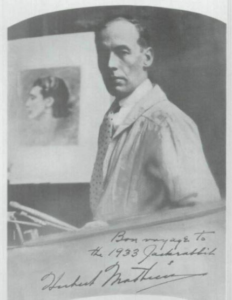 too) perceives the world in a new way. If hemasters the appropriate technique, he is also able to produce art with a very high communication potential. On what role technique exactly plays, Hubbard mentioned in a bulletin of July 29, 1973 his discussions with “the late Hubert Mathieu” (Hubbard 1991:16). Although some who later wrote about Hubbard were unable to identify him or speculated he was a fictional character, in fact Mathieu (1897-1954) was a distinguished South Dakota illustrator and artist [Image at right], who worked for magazines Hubbard was familiar with.
too) perceives the world in a new way. If hemasters the appropriate technique, he is also able to produce art with a very high communication potential. On what role technique exactly plays, Hubbard mentioned in a bulletin of July 29, 1973 his discussions with “the late Hubert Mathieu” (Hubbard 1991:16). Although some who later wrote about Hubbard were unable to identify him or speculated he was a fictional character, in fact Mathieu (1897-1954) was a distinguished South Dakota illustrator and artist [Image at right], who worked for magazines Hubbard was familiar with.
Based inter alia on the ideas of Mathieu, Hubbard concluded that in the arts communication (the end) is more important than technique (the means), but technique is not unimportant. Artists who are well-trained are able to communicate in different styles, including the non-figurative, and the audience understands intuitively that they are real artists. Perceiving the world and representing it from the superior viewpoint of the thetan is not enough. One should be able to communicate this to the audience, which however should be invited to “contribute part of the meaning” (Hubbard 1991: 91) This is precisely the difference between fine art and mere illustration, where little is left to the audience’s own contribution.
Communication is achieved through integration, or combination into an integral whole of elements such as perspective, lines, colors, and rhythm. Hubbard emphasized “mood lines,” i.e. abstract line forms that influence the audience’s emotional response. Vertical lines communicate drama and inspiration, horizontal lines, happiness and calm, and so on (Hubbard 1991:76-77). There are several systems of mood lines described in manuals for artists. Scientology uses the one developed by visionary landscape architect John Ormsbee Simonds (1913-2005). Simonds’ theory of form was influenced by Zen Buddhism and by Anthroposophical theories he was exposed to through his mentor at Harvard, Marcel Breuer (1902-1981), formerly of the Bauhaus. Another common tool Hubbard recommended to artists, the color wheel, was promoted in his times through references to market surveys, but in fact had been first used in a different context by Robert Fludd (1574-1637) and Johann Wolfgang von Goethe (1749-1832). Like many Theosophists (and market researchers), Hubbard believed that colors correspond to specific emotional states.
NOTABLE MEMBER ARTISTS
Becker Mirlach, Petra (b. 1944). German painter.
Bennish, Gracia (b. 1943). American painter and photographer.
Collins, Leisa (b. 1958). American painter.
Díaz-Rivera, Susana (b. 1957). Mexican painter.
Duke, Renée (1927-2011). American painter.
Escallon, Natalia (b 1985). Colombian painter and photographer.
Farina, Franco (b. 1957). Italian painter.
Findlay, Beatrice (b. 1941). Canadian painter, currently residing in Brooklyn, New York.
Gáll, Gregor (b. 1957). Hungarian sculptor.
Galli, Eugenio (b. 1951). Italian painter.
Green Peter (b. 1945). American painter.
Hancock, Houston (b. 1943). American painter.
Hanson, Erin (b. 1981). American painter.
Helnwein, Gottfried (b. 1948). Austrian painter and performance artist.
Helnwein, Mercedes (b. 1979). Austrian-born American painter and writer.
Hepner, Pomm (b. 1956). American painter.
Holl Hunt, Pamela (b. 1945). English painter.
Hubbard, Arthur Conway (b. 1958). American painter, son of Scientology founder, L. Ron Hubbard.
Hunter, Madison (b. 1989). American sculptor.
Kelly, Carolyn (1945-2017). American cartoonist and artist, daughter of well-known American cartoonist Walt Kelly (1913-1973), the creator of Pogo.
Mirlach, Max (b. 1944). German painter.
Munro, Ross (b. 1948). Canadian painter.
Prager, Vanessa (b. 1984). American painter.
Röhrig, Carl-W. (b. 1953). German painter, currently residing in Switzerland.
Rose, Marlene (b. 1967). Glass sculptor.
Rotenberg, Jule (b. 1954). American sculptor.
Sandoz, Claude (b. 1946). Swiss painter.
Schoeller Robert (b. 1950). Austrian painter, currently residing in Clearwater, Florida.
Shereshevsky, Barry (b. 1942). American painter.
South, Randolph (“Randy,” aka Carl Randolph) (b. 1950). American painter.
Spencer, Joe (b. 1949). American painter.
Warren, Jim (b. 1949). American painter.
Wright, D. Yoshikawa (b. 1951). American sculptor.
Wunderer, Bia (b. 1943). German painter.
Zöllner, Waki (1935-2015). German painter and sculptor.
INFLUENCE ON ARTISTS
Among modern new religious movements, Scientology is unique for its conscious effort of transmitting its worldview to the artists, at the same time teaching them how to be more apt at communicating their art to their audiences, through its courses and seminaries taught in its Celebrity Centers. Yet, Scientology’s influence on artists is understudied. One of the 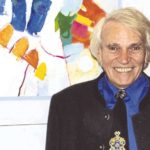 reasons lies in the attacks and discrimination some artists have received because of their association with Scientology, particularly in Germany. There, abstract painter and textile artist Bia Wunderer is one of the artists who had exhibitions cancelled because she was “exposed” as a Scientologist. This made some artists understandably reluctant to discuss their relationship with Scientology. However, in Germany, of all places, artists were involved in Scientology since its beginnings. When he died in 2015, painter and sculptor Waki Zöllner (1935-2015), who had joined Scientology in 1968, was the German with more years of Scientology training. [Image at right]
reasons lies in the attacks and discrimination some artists have received because of their association with Scientology, particularly in Germany. There, abstract painter and textile artist Bia Wunderer is one of the artists who had exhibitions cancelled because she was “exposed” as a Scientologist. This made some artists understandably reluctant to discuss their relationship with Scientology. However, in Germany, of all places, artists were involved in Scientology since its beginnings. When he died in 2015, painter and sculptor Waki Zöllner (1935-2015), who had joined Scientology in 1968, was the German with more years of Scientology training. [Image at right]
The most famous international artist who took Scientology courses for several years, starting in 1972, was the Austrian-born Gottfried Helnwein (b. 1948). He became increasingly involved in Scientology’s activities, with all his family, and was attacked by anti-cult critics, who promoted even a book against him (Reichelt 1997). This generated in turn court cases and Helnwein’s increasing reluctance to discuss his religious beliefs.
In 1975, Helnwein told Stuttgart’s Scientology magazine College that “Scientology has caused a consciousness explosion in me” (Helnwein 1975). In 1989, in an interview in Scientology’s Celebrity, Helnwein elaborated that Scientology offers to artists invaluable tools to survive in a world often hostile to them, but also gave him a “new viewpoint” and an understanding how “people would react to my art” (Helnwein 1989a:10-11).
American novelist William Burroughs (1914-1997) took several Scientology courses between 1959 and 1968. Later, he rejected Scientology as an organization, while maintaining an appreciation for its techniques. In 1990, he wrote an essay about Helnwein, calling him “a master of surprised recognition,” which he defined as the art “to show the viewer what he knows but does not know that he knows” (Burroughs 1990:3) In this sense, “surprised recognition” may also describe the moment when a thetan “remembers” his true nature.
Helnwein’s unique style and approach to reality, a “photorealism” where paintings often look as photographs (but aren’t), derive from multiple sources. Ultimately, however, we can perhaps see in Helnwein’s works an attempt to depict the world as a thetan sees it, finally realizing he is its creator.
Seen as it really is, the world is not always pleasant, and includes suppression and totalitarianism. Some of Helnwein’s most famous paintings include suffering children. Helnwein exposes there the society’s unacknowledged cruelty. But there is also hope. The artist is aware of Hubbard’s ideas about children as spiritual beings occupying young bodies. Armed with the technology, children can survive and defeat suppression.
Criticizing psychiatry’s abuses is a cause dear to Scientologists. In 1979, leading Austrian psychiatrist Heinrich Gross (1915-2005), who participated in the Nazi program for the euthanasia of mentally handicapped children, defended himself by stating that children were killed in a somewhat humane way, with poison. Helnwein reacted with a watercolor, Lives unworthy of being lived, depicting a child “humanely” poisoned by Gross.
Helnwein also looked provocatively at Nazism and the Holocaust as an evil the German and Austrian society still refused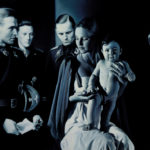 to confront. In his famous Epiphany I (1996), the child may or may not be a young Adolf Hitler (1889-1945), but the Three Kings are clearly Nazi officers. [Image at right] Helnwein wants the audience, as Hubbard suggested, to contribute part of the meaning and to understand by itself.
to confront. In his famous Epiphany I (1996), the child may or may not be a young Adolf Hitler (1889-1945), but the Three Kings are clearly Nazi officers. [Image at right] Helnwein wants the audience, as Hubbard suggested, to contribute part of the meaning and to understand by itself.
Born in 1948, Helnwein reports how he escaped from Vienna’s suffocating conformism through comics, something the Austrian educational establishment did not approve of at that time. He maintains a fascination for Disney’s Donald Duck and the creator of several Donald stories, Carl Barks (1901-2000), who became his friend. Both Mickey Mouse and Donald are featured in Helnwein’s work. Barks, Helnwein wrote, created a “decent world where one could get flattened by steam-rollers and perforated by bullets without serious harm. A world in which the people still looked proper (..). And it was here that I met the man who would forever change my life – a man who (…) is the only person today that has something worthwhile saying – Donald Duck” (Helnwein 1989b:16). Perhaps, again, Barks’ Duckburg became a metaphor for Helnwein of the “clear” world created by a technology capable of restoring the thetans to their proper role. In 2013, Helnwein was honored by a great retrospective at Vienna’s Albertina, which attracted 250,000 visitors, a far cry from when the artist was discriminated as a Scientologist.
While Helnwein became reserved on his relationship with Scientology, other artists declared it openly. Scientology through its Celebrity Centers also created a community of artists, knowing and meeting each other across different countries, continents, and styles. Several Scientologist artists decided to live either in Los Angeles or in Clearwater, Florida, near the main centers of the Church of Scientology.
Scientologist artists do not share a single style, as is true for artists who are Theosophists or Catholics. For example, German-born Carl-W. Röhrig (1953-), currently residing in Switzerland, calls his art “fantastic realism” and is also influenced by fantasy literature, surrealism, and popular esotericism (von Barkawitz 1999), as evidenced by his successful deck of tarot cards 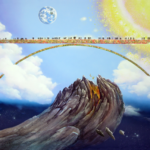 (Röhrig and Marzano-Fritz 1997). There are, however, common themes among Scientology artists, as evidenced in interviews I conducted between 2015 and 2016 with a number of them (the subsequent quotes, unless otherwise indicated, are from those interviews).
(Röhrig and Marzano-Fritz 1997). There are, however, common themes among Scientology artists, as evidenced in interviews I conducted between 2015 and 2016 with a number of them (the subsequent quotes, unless otherwise indicated, are from those interviews).
Röhrig is among the few Scientologist artists who included explicit references to Scientology doctrines in some of his paintings, including The Bridge (2009), i.e. the journey to become free from the effects of the reactive mind. [Image at right] Röhrig and other artists who are Scientologists, including the American Pomm Hepner and Randy South (aka Carl Randolph), also contributed murals to churches of Scientology around the world.
California Scientologist artist Barry Shereshevsky devoted several paintings to the ARC triangle. California sculptor D. Yoshikawa Wright moved “from Western to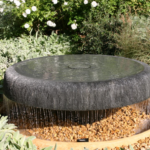 more Eastern thought,” rediscovering his roots, and finally found in Scientology something that, he says, “merges East and West.” About his Sculptural Waterfalls, he comments that the stone represents the thetan, the water the physical universe as motion, and their relationship the rhythm, the dance of life [Image at right]. Another Scientologist sculptor (and painter), the Italian Eugenio Galli, experiments with rhythm and motion through different abstract compositions all connected with the idea of “transcendence,” i.e. transcending our present, limited status.
more Eastern thought,” rediscovering his roots, and finally found in Scientology something that, he says, “merges East and West.” About his Sculptural Waterfalls, he comments that the stone represents the thetan, the water the physical universe as motion, and their relationship the rhythm, the dance of life [Image at right]. Another Scientologist sculptor (and painter), the Italian Eugenio Galli, experiments with rhythm and motion through different abstract compositions all connected with the idea of “transcendence,” i.e. transcending our present, limited status.
Artists who went through Scientology’s Art course all insisted on art as communication. Winnipeg-born New York abstract artist Beatrice Findlay told me that “art is communication, why the heck would you do it otherwise?” She also insisted that Hubbard 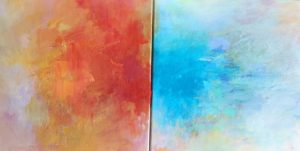 “never said abstract art communicated less” and had a deep appreciation of music, a form of abstract communication par excellence. Hubbard’s ideas about composition are translated by Findlay into peculiar abstract lines and color (Carasso 2003) [Image at right]. A similar abstract approach while other Scientologist artist apply the same principles to more traditional approach to landscape. They include the Italian Franco Farina, the Canadian Ross Munro, and the American Erin Hanson, whose depictions of national parks and other iconic American landscapes in a style she calls “Open Impressionism” won critical acclaim (Hanson 2014; Hanson 2016).
“never said abstract art communicated less” and had a deep appreciation of music, a form of abstract communication par excellence. Hubbard’s ideas about composition are translated by Findlay into peculiar abstract lines and color (Carasso 2003) [Image at right]. A similar abstract approach while other Scientologist artist apply the same principles to more traditional approach to landscape. They include the Italian Franco Farina, the Canadian Ross Munro, and the American Erin Hanson, whose depictions of national parks and other iconic American landscapes in a style she calls “Open Impressionism” won critical acclaim (Hanson 2014; Hanson 2016).
Pomm Hepner is both a professional artist and a senior technical supervisor at Scientology’s church in Pasadena, as well as a leader in Artists for Human Rights, an advocacy organization started by Scientologists. As Scientology taught her “on the spiritual world,” she evolved, she says, from “pretty things” to “vibrations,” from “a moment that exists to a moment I create… I can bring beauty to the world and no longer need to depend on the world bringing beauty to me.” By adopting the point of view of the thetan, she tried to “reverse” the relationship between the artist and the physical universe. A similar experience emerges in the artistic and literary career of Scientologist Renée Duke (1927-2011). Although she had painted before, she became a professional painter only later in life, after she had encountered Scientology (Duke 2012).
There is a difference between how Scientologist artists were discriminated against in Europe and 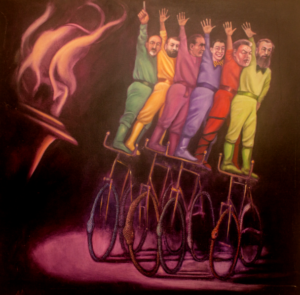 some mild hostility their beliefs received occasionally in the U.S. However, they all stated in my interviews that modern society is often disturbed by artists and tries to suppress them, singling out psychiatry as a main culprit, a recurring theme in Scientology. The Trick Cyclist by Randolph South depicts well-known psychiatrists and “was created to draw attention to the evil practice of psychiatry.” [Image at right] Most Scientologist artists share an appreciation of Helnwein, although they may be very far away from both his art and his persona. Some address the theme of suffering children with obvious Helnweinian undertones. The youngest child of L. Ron Hubbard, Arthur Conway Hubbard (1958-), himself became a painter and studied under Helnwein, although he also produced works in a different style. In some of his paintings, he used his own blood.
some mild hostility their beliefs received occasionally in the U.S. However, they all stated in my interviews that modern society is often disturbed by artists and tries to suppress them, singling out psychiatry as a main culprit, a recurring theme in Scientology. The Trick Cyclist by Randolph South depicts well-known psychiatrists and “was created to draw attention to the evil practice of psychiatry.” [Image at right] Most Scientologist artists share an appreciation of Helnwein, although they may be very far away from both his art and his persona. Some address the theme of suffering children with obvious Helnweinian undertones. The youngest child of L. Ron Hubbard, Arthur Conway Hubbard (1958-), himself became a painter and studied under Helnwein, although he also produced works in a different style. In some of his paintings, he used his own blood.
Pollution as a form of global suppression and Scientology’s mission to put an end to it are a main theme for Röhrig. Landscapes and cultures in developing countries are also in danger of being suppressed. This is a main theme in the work of Swiss Scientologist artist Claude Sandoz, who spends part of his time in the Caribbean, in Saint Lucia. Exhibitions of Sandoz’s works, which blends Caribbean and European themes and styles, [Image at right] took place in several Swiss museums (see Stutzer and Walser Beglinger 1994).
theme for Röhrig. Landscapes and cultures in developing countries are also in danger of being suppressed. This is a main theme in the work of Swiss Scientologist artist Claude Sandoz, who spends part of his time in the Caribbean, in Saint Lucia. Exhibitions of Sandoz’s works, which blends Caribbean and European themes and styles, [Image at right] took place in several Swiss museums (see Stutzer and Walser Beglinger 1994).
Some of those who took Scientology’s Art Course are “commercial” artists. The course told them that this is not a shame and hailed success as healthy. They believe that the boundary between commercial and fine art is not clear-cut. Some of them were encouraged to also engage in fine arts. Veteran Scientologist artist Peter Green claims he understood through Scientology that commercial artists are not “coin-operated artists,” but have their own way of communicating and presenting a message. Green manifested this approach in his iconic posters, such as a famous one of Jimi Hendrix (1942-1970). Green also contributed to horror comics magazines published by the Warren company in California, and keeps producing his successful Politicards, i.e. trading and playing cards with politicians (see Kelly 2011). He insists that you can “paint to live and remain sane. And in the end, you may live to paint too.” Randy South insisted that, even when working for advertising, artists may “perceive the physical universe” as “not overwhelming spirituality” but “vice versa.” He added that “Hubbard said that life is a game. I want to play the game, and it’s fun.”
The portraits of another Scientologist artist, Robert Schoeller, are sold for commercial purposes, but he believes that “by painting somebody I make him spiritual.” In fact, there have been museum exhibitions of his portraits around the central theme of spirituality. Similar considerations may be  made for Jim Warren’s popular lithographs and Disney-related themes. Other Scientologist artists became photographers and cartoonists. Carolyn Kelly (1945-2017) was the daughter of well-known American cartoonist Walt Kelly (1913-1973), the creator of Pogo. She was a cartoonist and illustrator in her own right, and was among those who designed her father’s Pogo when the strip was shortly revived in the 1990s. [Image at right]
made for Jim Warren’s popular lithographs and Disney-related themes. Other Scientologist artists became photographers and cartoonists. Carolyn Kelly (1945-2017) was the daughter of well-known American cartoonist Walt Kelly (1913-1973), the creator of Pogo. She was a cartoonist and illustrator in her own right, and was among those who designed her father’s Pogo when the strip was shortly revived in the 1990s. [Image at right]
Some (but not all) Scientologist artists took an interest in popular esoteric discourse. Before meeting Scientology, Pomm Hepner, was exposed to Anthroposophy by studying at a Steiner school. Röhrig uses the Tarots as well as the Zodiac. He explains he doesn’t believe in the content of astrology or Tarot, as “they are effects and as a Scientologist you try to be cause,” but they provide a widely shared language and are “a very good tool to communicate.” Other Scientologist artists approach in a similar way Eastern spirituality. For instance, Marlene Rose’s glass sculptures often feature the Buddha. Rose is one of the artists who decided to live in Clearwater, Florida, near the Flag headquarters of the Church of Scientology. The area offers a favorable environment for artists working with glass and in April 2017 nearby St. Petersburg opened the Imagine Museum devoted to this artistic medium, with Marlene Rose featured in the opening exhibit.
“We were one hundred students doing the same [Scientology] course. Suddenly, the room took the most beautiful characteristics. Everything became magical. I became more me. The room did not 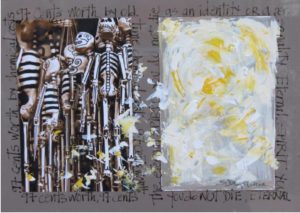 change but how I perceived it changed,” reported Susana Díaz-Rivera, a Mexican Scientologist painter. Several artists told how the “static” experience, which in Scientology language means realizing your nature as thetan, completely changed how they perceive the world. Then, “art is about duplicating what you perceive. Perception is communication,” as Yoshikawa Wright told me. Díaz-Rivera struggled to recapture and express this perception of herself as a thetan. She tried both painting [Image at right] and photographing in different locations, including Rome and Los Angeles, and using mirrors. “The spiritual part, she said, emerges through the mirrors.”
change but how I perceived it changed,” reported Susana Díaz-Rivera, a Mexican Scientologist painter. Several artists told how the “static” experience, which in Scientology language means realizing your nature as thetan, completely changed how they perceive the world. Then, “art is about duplicating what you perceive. Perception is communication,” as Yoshikawa Wright told me. Díaz-Rivera struggled to recapture and express this perception of herself as a thetan. She tried both painting [Image at right] and photographing in different locations, including Rome and Los Angeles, and using mirrors. “The spiritual part, she said, emerges through the mirrors.”
Scientology, the artists who attended its courses reported, offers to the artist a number of suggestions, aimed at “putting them back in the driver’s seat” (Peter Green) of their lives, exposing the “myth” of the dysfunctional, starving artist. Scientology also creates and cultivates a community of artists, and does more than offering practical advice. By interiorizing the gnostic narrative of the thetan, artists learn to perceive the physical universe in a different way. Then, they try to share this perception through communication, with a variety of different techniques and styles, inviting the audience to enhance their works with further meanings.
Sixty-two sculptures in the Grand Atrium of the new Flag Building in Clearwater, Florida, inaugurated in 2013, illustrate the fundamental concepts of Scientology. The fact that these concepts had to be  explained to the artists, none of them a Scientologist, is significant. Artists who are Scientologists normally are inspired by Scientology in their work, but prefer not to “preach” or illustrate its doctrines explicitly. On the other hand, although not realized by Scientologists, the Flag complex of sculptures is part and parcel of an art inspired by Hubbard and Scientology. [Image at right]
explained to the artists, none of them a Scientologist, is significant. Artists who are Scientologists normally are inspired by Scientology in their work, but prefer not to “preach” or illustrate its doctrines explicitly. On the other hand, although not realized by Scientologists, the Flag complex of sculptures is part and parcel of an art inspired by Hubbard and Scientology. [Image at right]
In 2008, the Los Angeles magazine Ange described the circle of young artists who are Scientologists, including painter and novelist Mercedes Helnwein (Gottfried Helnwein’s daughter) and promising abstract artist Vanessa Prager as the “first generation of casual Scientologists,” whose religious affiliation caused less controversy (Brown 2008). Visual arts seem to offer an ideal window to discuss the worldview and multiple influences of Scientology independently of the usual legal and other controversies.
IMAGES**
**All images are clickable links to enlarged representations.
Image #1: L. Ron Hubbard, portrait by Peter Green (1999).
Image #2: Cover of Science of Survival, 1951.
Image #3: Cover of L. Ron Hubbard posthumously published Art, 1991.
Image #4: Hubert Mathieu.
Image #5: Waki Zöllner.
Image #6: Gottfried Helnwein, Epiphany I (1996).
Image #7: Carl-W. Röhrig, The Bridge (2009).
Image #8: D. Yoshikawa Wright, Rain Circle, from the series Sculptural Waterfalls (2010).
Image #9: Beatrice Findlay, December Fog Runners (2015).
Image #10: Randolph South, The Trick Cyclist (2008).
Image #11: Claude Sandoz, Ixora II (Elvira Bach and Her Children) (1997-98).
Image #12: Pogo characters designed by Carolyn Kelly.
Image #13: Bones and the Eternal Spirit (2014), Susana Díaz-Rivera’s contribution to the exhibition Dialogue on Death at the Diocesan Museum of Gubbio, Italy, 2015. All the words in the painting are by L. Ron Hubbard.
Image #14: Part of the groups of sculptures The Eight Dynamics, The Flag Building, Clearwater, Florida.
REFERENCES
Brown, August. 2008. “The Radar People.” Ange, November. Accessed from http://digital.modernluxury.com/article/The+Radar+People/93054/10070/article.html on 26 March 2007.
Burroughs, William. 1990. “Helnwein’s Work.” P. 3 in Kindskopf, edited by Peter Zawrel, Vienna: Museum Niederösterreich.
Carasso, Roberta. 2003. Beatrice Findlay Runners/Landscapes. Santa Monica, CA: Bergamot Station Art Center.
Duke, Renée. 2012. Cocktails, Caviar and Diapers: A Woman’s Journey to Find Herself through Seven Countries, Six Children and a Dog. Charleston, SC: Alex Eckelberry.
Hanson, Erin. 2016. Open Impressionism, Volume II. San Diego, CA: Red Rock Fine Art.
Hanson, Erin. 2014. Open Impressionism: The Landscapes of Erin Hanson. San Diego, CA: Red Rock Fine Art.
Helnwein, Gottfried. 1989a. “Celebrity Interview of the Month: Fine Artist Gottfried Helnwein.” Celebrity 225:8-11.
Helnwein, Gottfried. 1989b. “Micky Maus unter dem roten Stern.” Zeitmagazin, April, 12-13.
Helnwein, Gottfried. 1975. Interview in College: Zeitschrift des Stuttgarter Dianetic College e.V., no. 12.
Hubbard, L. Ron. 1991. Art. Los Angeles: Bridge Publications.
Hubbard, L. Ron. 1976a. The Technical Bulletins of Dianetics and Scientology. Volume I 1950-53, Copenhagen and Los Angeles: Scientology Publications.
Hubbard, L. Ron. 1976b. The Technical Bulletins of Dianetics and Scientology. Volume VI 1965-1969, Copenhagen and Los Angeles: Scientology Publications.
Hubbard, L. Ron. 1951. Science of Survival: Simplified, Faster Dianetic Techniques. Wichita, KS: The Hubbard Dianetic Foundation.
Kelly, Tiffany. 2011. “Political Satire is in the Cards.” Los Angeles Times, October 7. Accessed from http://www.latimes.com/tn-gnp-1007-green-story.html on 26 March 2017.
Reichelt, Peter. 1997. Helnwein und Scientology. Lüge und Verrat eine Organisation und ihr Geheimdienst. Mannheim, Germany: Brockmann und Reichelt.
Röhrig, Carl-W. and Francesca Marzano-Fritz. 1997. The Röhrig-Tarot Book. Woodside (California): Bluestar Communications.
Stutzer, Beat, and Annakatharina Walser Beglinger. 1994. Claude Sandoz. Ornamente des Alltags. Chur: Bündner Kunstmuseum
Von Barkawitz, Volker. 1999. The Future is Never Ending: The Phantastic [sic] Naturalism of Carl-W. Röhrig. Hamburg (Germany): CO-Art.
Post Date:
9 May 2017
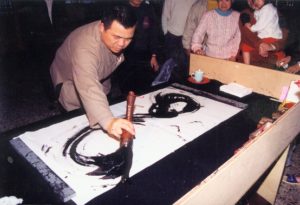 Grand Master Hun Yuan [Image at right] is one of these founders of religious movements who also emerged as significant artists in their own merit. In this sense, he can be compared to Oberto Airaudi, who founded Damanhur in Italy (Zoccatelli 2016), and to Adi Da Samraj (Franklin Jones), the leader and founder of Adidam in the United States (Bradley-Evans 2017). Like Airaudi and Adi Da, Hun Yuan is revered as the founder of a new religious movement by his followers, while on the other hand his artwork is appreciated even by artists and critics who are not interested in joining his group (see Carbotti 2017).
Grand Master Hun Yuan [Image at right] is one of these founders of religious movements who also emerged as significant artists in their own merit. In this sense, he can be compared to Oberto Airaudi, who founded Damanhur in Italy (Zoccatelli 2016), and to Adi Da Samraj (Franklin Jones), the leader and founder of Adidam in the United States (Bradley-Evans 2017). Like Airaudi and Adi Da, Hun Yuan is revered as the founder of a new religious movement by his followers, while on the other hand his artwork is appreciated even by artists and critics who are not interested in joining his group (see Carbotti 2017).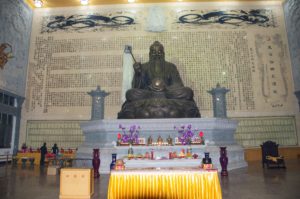 development of the worldview and divination method taught in the Chinese classic book I Ching. [Image at right]
development of the worldview and divination method taught in the Chinese classic book I Ching. [Image at right]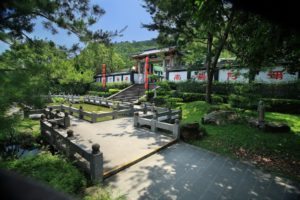 architects who are not part of Weixin Shengjiao, but his main achievement are the movement’s temples, including the headquarters in Nantou County [Image at right] and two Cities of Eight Trigrams, one in Taiwan and one in Henan, China. Grand Master Hun Yuan would however deny that considerations about Feng Shui and aesthetics are part of two separate realms. He teaches that what is in accordance with Feng Shui conveys an image of harmony, and as such is also beautiful.
architects who are not part of Weixin Shengjiao, but his main achievement are the movement’s temples, including the headquarters in Nantou County [Image at right] and two Cities of Eight Trigrams, one in Taiwan and one in Henan, China. Grand Master Hun Yuan would however deny that considerations about Feng Shui and aesthetics are part of two separate realms. He teaches that what is in accordance with Feng Shui conveys an image of harmony, and as such is also beautiful.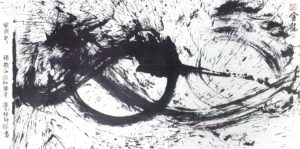 vitality.” He spent the whole day painting The Golden Dragon of Fulfilled Wishes with a heavy brush. [Image at right] In the end, he did not feel tired, which he interpreted as an auspicious sign (Hun Yuan 2007:2). In the meantime, he had also inaugurated a distinctive style of painting, and he would never look back.
vitality.” He spent the whole day painting The Golden Dragon of Fulfilled Wishes with a heavy brush. [Image at right] In the end, he did not feel tired, which he interpreted as an auspicious sign (Hun Yuan 2007:2). In the meantime, he had also inaugurated a distinctive style of painting, and he would never look back.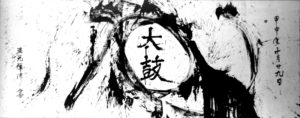 “blessing of all holy deities” emanating from the painting (Hun Yuan 2017:25). [Image at right]
“blessing of all holy deities” emanating from the painting (Hun Yuan 2017:25). [Image at right]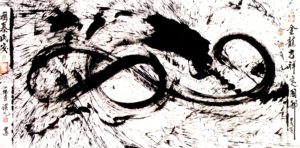 reproduced example is The Stable Nation of the Golden Dragon, admired by critics but also regarded as a sacred painting by devotees. [Image at right]
reproduced example is The Stable Nation of the Golden Dragon, admired by critics but also regarded as a sacred painting by devotees. [Image at right]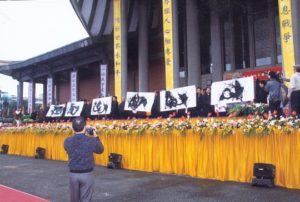 comments at the Exhibition of Zen, held at Sun Yat-Sen Memorial Hall in Taipei in 2000. [Image at right] While he was almost ready to sell the paintings, which were exhibited outdoor, “it suddenly rained and the six pieces […] were all wet and blurred. At that moment, Grand Master Hun Yuan Chanshi realized the underlying meaning, ‘No sale!’ instructed by Buddha” (Huang 2011:16). The incident typically captures the dilemma whether these sacred artifacts should be considered “works of art” in the sense in which this expression is commonly understood in the twenty first century. But this is a problem common to all genuinely religious art, particularly when it is produced mostly for the internal purpose of beautifying the devotees’ homes and the movement’s places of worship.
comments at the Exhibition of Zen, held at Sun Yat-Sen Memorial Hall in Taipei in 2000. [Image at right] While he was almost ready to sell the paintings, which were exhibited outdoor, “it suddenly rained and the six pieces […] were all wet and blurred. At that moment, Grand Master Hun Yuan Chanshi realized the underlying meaning, ‘No sale!’ instructed by Buddha” (Huang 2011:16). The incident typically captures the dilemma whether these sacred artifacts should be considered “works of art” in the sense in which this expression is commonly understood in the twenty first century. But this is a problem common to all genuinely religious art, particularly when it is produced mostly for the internal purpose of beautifying the devotees’ homes and the movement’s places of worship.
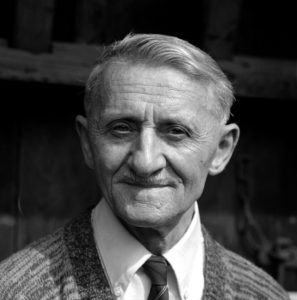
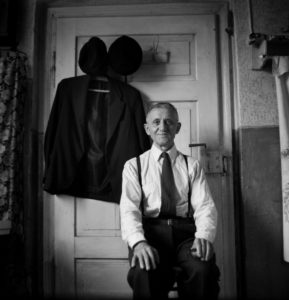
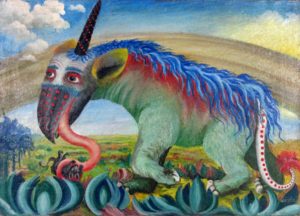
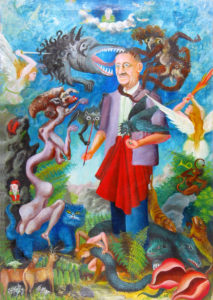
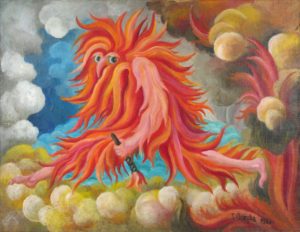















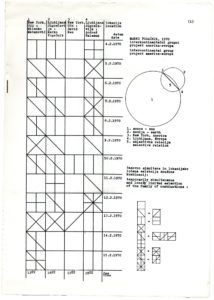
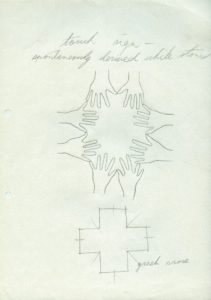

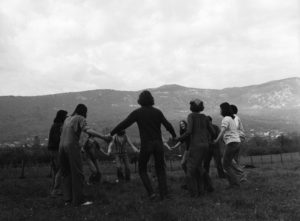
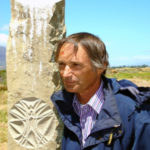
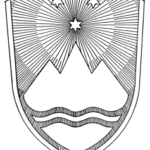
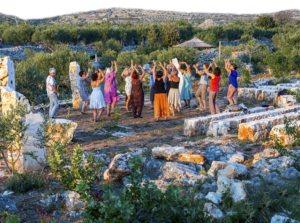
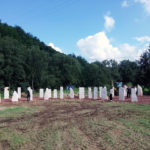
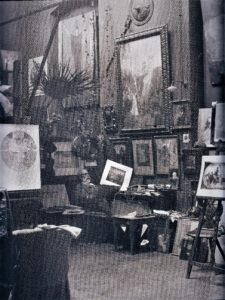
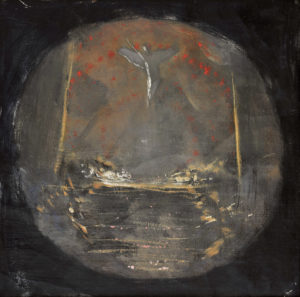
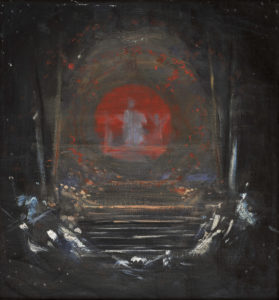
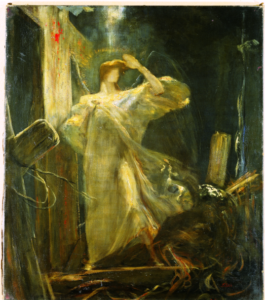
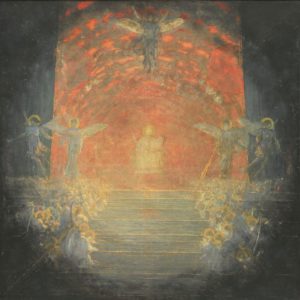
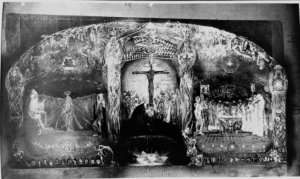 viewer a sense of incompleteness. With his series of drawings made with Indian ink on photographic foil, intended to be seen in front of a light source (a technique invented by Gyzis himself) the painter was hinting at an otherworldly universe, like the one explored by Spiritualist mediums. [Image at right] Similarly, the sketches in black paper with white chalk, that he produced, in 1898, with Anna May’s aid (Drosinis 1953:235), evoke the idea of a juxtaposition between an earthly reality and a spiritual otherness. The latter were bought from the Bavarian Government and are now kept in Staatliche Graphische Sammlung in Munich.
viewer a sense of incompleteness. With his series of drawings made with Indian ink on photographic foil, intended to be seen in front of a light source (a technique invented by Gyzis himself) the painter was hinting at an otherworldly universe, like the one explored by Spiritualist mediums. [Image at right] Similarly, the sketches in black paper with white chalk, that he produced, in 1898, with Anna May’s aid (Drosinis 1953:235), evoke the idea of a juxtaposition between an earthly reality and a spiritual otherness. The latter were bought from the Bavarian Government and are now kept in Staatliche Graphische Sammlung in Munich.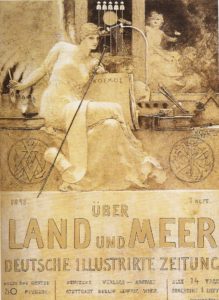
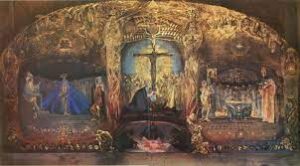
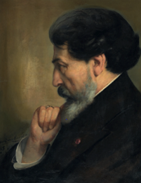 Asked about Jean Delville (1867-1953), [Image at right] many contemporary Belgians would simply answer: “Delville, never heard of him!” However, when paintings such as the Portrait of Madame Stuart Merrill (now at the Brussels Museum of Fine Arts), The School of Plato (at Paris’ Musée d’Orsay), or The Love of Souls (at the Museum of Ixelles, Brussels), are mentioned, many would recognize them as iconic symbolist works. His works survive, and position Delville among the great symbolist painters. But Delville the man has disappeared and his works, in a way, have been taken hostage by critics in such a way as to make their author invisible. In part, Delville himself is to blame: a brilliant artist and intellectual, but difficult in person, he was known to practice “the delicate art of making enemies.” His family and descendants also shoulder some of the blame, having fashioned a sanitized, official version of his tumultuous life, which cared little for his esoteric inclinations and glossed over him leaving his family at the age of sixty-seven to live with a young student, Émilie Leclercq (1904-1992).
Asked about Jean Delville (1867-1953), [Image at right] many contemporary Belgians would simply answer: “Delville, never heard of him!” However, when paintings such as the Portrait of Madame Stuart Merrill (now at the Brussels Museum of Fine Arts), The School of Plato (at Paris’ Musée d’Orsay), or The Love of Souls (at the Museum of Ixelles, Brussels), are mentioned, many would recognize them as iconic symbolist works. His works survive, and position Delville among the great symbolist painters. But Delville the man has disappeared and his works, in a way, have been taken hostage by critics in such a way as to make their author invisible. In part, Delville himself is to blame: a brilliant artist and intellectual, but difficult in person, he was known to practice “the delicate art of making enemies.” His family and descendants also shoulder some of the blame, having fashioned a sanitized, official version of his tumultuous life, which cared little for his esoteric inclinations and glossed over him leaving his family at the age of sixty-seven to live with a young student, Émilie Leclercq (1904-1992).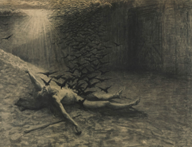 Louvain, Belgium, on January 19, 1867. His family subsidized his evening classes at the Brussels Academy of Fine Arts, where he got his diploma in 1887. He led a charmed life, having by the tender age of twenty produced such masterpieces as L’Homme aux corbeaux, recently rediscovered in the dusty archives of the Belgian Royal Library [Image at right]. Still in his youth, he collaborated with L’Essor, one of the best-known art salons in Belgium. In 1892, he established in Brussels his own salon, Pour l’Art, followed in 1895 by a new salon, devoted to what he called “Idealist art.” In the same year 1895, he won the prestigious Prix de Rome in the category of painting. In 1897, he produced his first masterpiece, The School of Plato [Image at right]. He also published books, both of esoteric poetry and about art, starting with Les Horizons hantés in 1893 (Delville 1893) and Le Frisson du Sphinx in 1897 (Delville 1897), and culminating in 1900 with The New Mission of Art (Delville 1900),
Louvain, Belgium, on January 19, 1867. His family subsidized his evening classes at the Brussels Academy of Fine Arts, where he got his diploma in 1887. He led a charmed life, having by the tender age of twenty produced such masterpieces as L’Homme aux corbeaux, recently rediscovered in the dusty archives of the Belgian Royal Library [Image at right]. Still in his youth, he collaborated with L’Essor, one of the best-known art salons in Belgium. In 1892, he established in Brussels his own salon, Pour l’Art, followed in 1895 by a new salon, devoted to what he called “Idealist art.” In the same year 1895, he won the prestigious Prix de Rome in the category of painting. In 1897, he produced his first masterpiece, The School of Plato [Image at right]. He also published books, both of esoteric poetry and about art, starting with Les Horizons hantés in 1893 (Delville 1893) and Le Frisson du Sphinx in 1897 (Delville 1897), and culminating in 1900 with The New Mission of Art (Delville 1900), 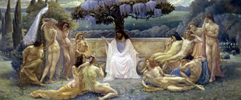 published with a preface by the famous Theosophist Édouard Schuré (1841-1929) and translated into English in 1910 (Delville 1910).
published with a preface by the famous Theosophist Édouard Schuré (1841-1929) and translated into English in 1910 (Delville 1910).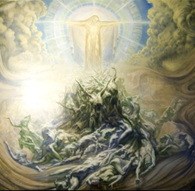 member of Kumris (or Kvmris), the Belgian branch of Papus’ French Groupe indépendant d’études ésotériques, and an organization that was an art salon and an occult circle at the same time.
member of Kumris (or Kvmris), the Belgian branch of Papus’ French Groupe indépendant d’études ésotériques, and an organization that was an art salon and an occult circle at the same time.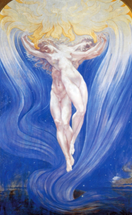 1900 and 1907, such as The God-Man, Love of Souls [Image at right], and Prometheus, were inspired by the occult, from his artistic subjects to the form, colors and symbols he used. Symbolism in general combined aesthetics and esotericism, particularly in France and Belgium. Jean Delville became one of its main representatives, along with the other Belgian symbolists, such as Fernand Khnopff (1858-1921) and Félicien Rops (1833-1898), and the French painters, particularly influenced by Theosophy and Schuré, known as the Nabis.
1900 and 1907, such as The God-Man, Love of Souls [Image at right], and Prometheus, were inspired by the occult, from his artistic subjects to the form, colors and symbols he used. Symbolism in general combined aesthetics and esotericism, particularly in France and Belgium. Jean Delville became one of its main representatives, along with the other Belgian symbolists, such as Fernand Khnopff (1858-1921) and Félicien Rops (1833-1898), and the French painters, particularly influenced by Theosophy and Schuré, known as the Nabis.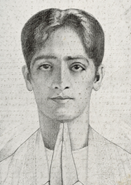 conferences (Delville 1913; 1925; 1928) [Image at right]. This would go on until Krishnamurti reached adulthood and disavowed his role in 1929, by declaring that he was neither the World Teacher nor a new Christ. For Delville, this marked a defeat, depression, and rupture.
conferences (Delville 1913; 1925; 1928) [Image at right]. This would go on until Krishnamurti reached adulthood and disavowed his role in 1929, by declaring that he was neither the World Teacher nor a new Christ. For Delville, this marked a defeat, depression, and rupture. the Academy’s bulletins, were written in Mons. As a painter, he also remained very active, rediscovering his creativity and producing some inspired Art Deco works, which today come as a surprise for those who know Delville when they learn of them, only because they were so neglected. In Mons [Image at right], Delville would produce several masterpieces in terms of the talent imbued in them and their scope, particularly the superb Roue du Monde, which is the property of the Royal Museum of Fine Arts in Antwerp, although unfortunately preserved in its reserve rather than displayed. As a citizen, too, he showed vivaciousness as a resistant against the occupying German forces, releasing deliberately contrarian works under the Nazis’ very noses.
the Academy’s bulletins, were written in Mons. As a painter, he also remained very active, rediscovering his creativity and producing some inspired Art Deco works, which today come as a surprise for those who know Delville when they learn of them, only because they were so neglected. In Mons [Image at right], Delville would produce several masterpieces in terms of the talent imbued in them and their scope, particularly the superb Roue du Monde, which is the property of the Royal Museum of Fine Arts in Antwerp, although unfortunately preserved in its reserve rather than displayed. As a citizen, too, he showed vivaciousness as a resistant against the occupying German forces, releasing deliberately contrarian works under the Nazis’ very noses.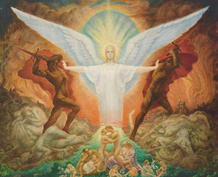 sculptor. Harvent observed Delville’s paintings in his workshop every day and took notes. In 1944, he watched him painting his famous Portrait of Madame Stuart Merrill, which the official biographies of Delville, as well as the Brussels Museum of Fine Arts, date back to 1892. Not so, claimed Harvent: it was painted in front of him in 1944 (note in the René Harvent archive, reproduced in Guéguen 2016:214).
sculptor. Harvent observed Delville’s paintings in his workshop every day and took notes. In 1944, he watched him painting his famous Portrait of Madame Stuart Merrill, which the official biographies of Delville, as well as the Brussels Museum of Fine Arts, date back to 1892. Not so, claimed Harvent: it was painted in front of him in 1944 (note in the René Harvent archive, reproduced in Guéguen 2016:214).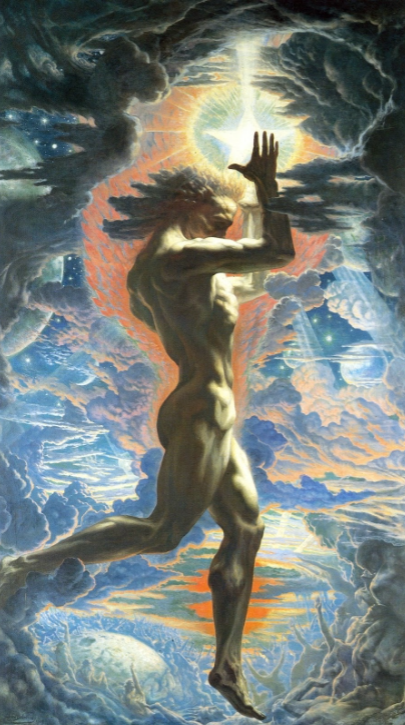 century (Laoureux 2014; Larvová 2015). A true academic study of Derville also started fairly recently (see Cole 2015), particularly with respect to his connections with Theosophy and esotericism (Clerbois 2012; Gautier 2011; Gautier 2012; Introvigne 2014; Guéguen 2016, 2017). Further studies on Delville the poet, Delville the musician, and Delville the art critic would hopefully follow.
century (Laoureux 2014; Larvová 2015). A true academic study of Derville also started fairly recently (see Cole 2015), particularly with respect to his connections with Theosophy and esotericism (Clerbois 2012; Gautier 2011; Gautier 2012; Introvigne 2014; Guéguen 2016, 2017). Further studies on Delville the poet, Delville the musician, and Delville the art critic would hopefully follow.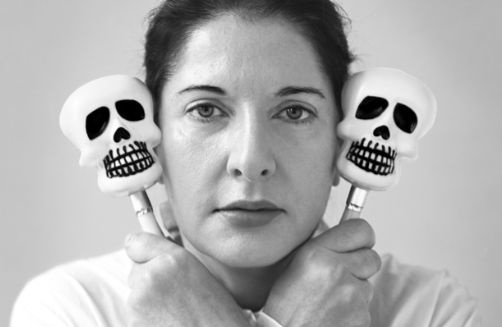 interpreted through political and feminist lenses, while the influence of Western esotericism has not been properly discussed. However, from the very beginning, Abramović’s art has been significantly affected by the New Age and other contemporary “alternative” spiritualities. In the period of her joint work with German artist Ulay (Frank Uwe Laysiepen, b. 1943), these esoteric pursuits became even more prominent. Later in her career, she came to present her performance art, which increasingly included the participation of the public, as a kind of spiritual practice. Eventually, she developed The Abramović Method, a syncretic mind-body-spirit training program for her followers, which drew on different sources such as New Age, the Armenian esoteric master George Ivanovich Gurdjieff (1866?-1949), vipassana meditation, Brazilian Spiritualism, and others.
interpreted through political and feminist lenses, while the influence of Western esotericism has not been properly discussed. However, from the very beginning, Abramović’s art has been significantly affected by the New Age and other contemporary “alternative” spiritualities. In the period of her joint work with German artist Ulay (Frank Uwe Laysiepen, b. 1943), these esoteric pursuits became even more prominent. Later in her career, she came to present her performance art, which increasingly included the participation of the public, as a kind of spiritual practice. Eventually, she developed The Abramović Method, a syncretic mind-body-spirit training program for her followers, which drew on different sources such as New Age, the Armenian esoteric master George Ivanovich Gurdjieff (1866?-1949), vipassana meditation, Brazilian Spiritualism, and others.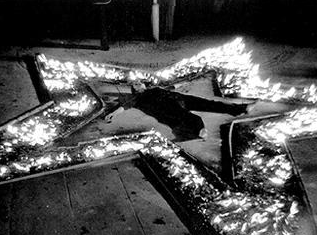 1974), during the III April Meetings in the SKC [Image at right]. Abramović doused with gasoline and lit a big wooden construction in the shape of what was easily recognized as the petokraka (“five-pointed star of Socialism ” in Serbian), a symbol of the regime. Abramović cut her hair, finger and toe nails, and threw them into the fire. Then she laid down in the blazing star, thus evoking the famous drawing of a man inscribed in a pentagram, from the book by Heinrich Cornelius Agrippa (1486-1535) De occulta philosophia (1533). Finally, she lost consciousness due to the lack of oxygen, and was saved from the flames by her colleagues.
1974), during the III April Meetings in the SKC [Image at right]. Abramović doused with gasoline and lit a big wooden construction in the shape of what was easily recognized as the petokraka (“five-pointed star of Socialism ” in Serbian), a symbol of the regime. Abramović cut her hair, finger and toe nails, and threw them into the fire. Then she laid down in the blazing star, thus evoking the famous drawing of a man inscribed in a pentagram, from the book by Heinrich Cornelius Agrippa (1486-1535) De occulta philosophia (1533). Finally, she lost consciousness due to the lack of oxygen, and was saved from the flames by her colleagues.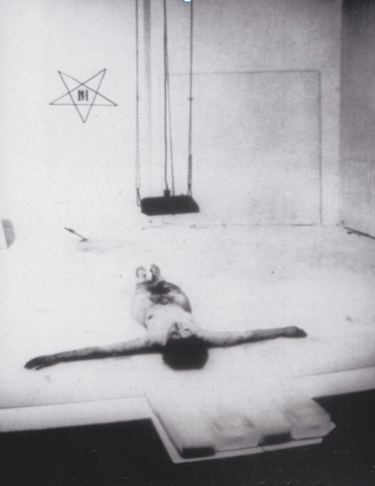 Innsbruck, Austria. [Image at right] The performance started with the “Eucharist,” in which she sat naked at a table, ate one jar of honey, and drank one bottle of red wine. Then she drew on the wall an inverted pentagram around the photography of Thomas Lips, a young Swiss man she wanted to seduce (Stokić 2008:42-44), cut the same inverted pentagram on her belly with a razor-blade, flagellated herself until she started to bleed, and finally “crucified” herself on a cross made of ice blocks.
Innsbruck, Austria. [Image at right] The performance started with the “Eucharist,” in which she sat naked at a table, ate one jar of honey, and drank one bottle of red wine. Then she drew on the wall an inverted pentagram around the photography of Thomas Lips, a young Swiss man she wanted to seduce (Stokić 2008:42-44), cut the same inverted pentagram on her belly with a razor-blade, flagellated herself until she started to bleed, and finally “crucified” herself on a cross made of ice blocks.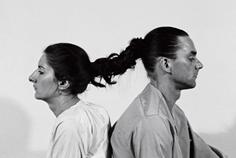 a series of performances in which they ran towards each other and collided at high speed (Relation in Space 1976), or spent hours with their long hairs tied together (Relation in Time 1977). [Image at right] In one interview from that time, Abramović said: “I feel the perfect human being is a hermaphrodite, because it’s half man, half woman, yet it’s a complete universe” (Kontova 1978:43).
a series of performances in which they ran towards each other and collided at high speed (Relation in Space 1976), or spent hours with their long hairs tied together (Relation in Time 1977). [Image at right] In one interview from that time, Abramović said: “I feel the perfect human being is a hermaphrodite, because it’s half man, half woman, yet it’s a complete universe” (Kontova 1978:43).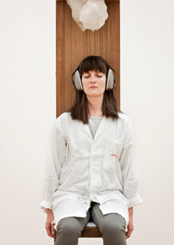 her Transitory Objects. These furniture-like objects, which she has been producing since 1988, are usually made by using crystals, copper, or magnets, materials which, according to Abramović, emanate an “energy” capable of healing or spiritually transforming the user. Abramović invites her public to sit, stand or lie on the exhibited Transitory Objects, eyes closed, without moving, in a way similar to what is done in vipassana meditation [Image at right]. According to Abramović, the purpose of her Transitory objects is to help her followers in their spiritual development. When humanity would reach the sought-for spiritual transformation, no objects would be necessary, and that is why she calls them “transitory.” Abramović presents her work with the Transitory objects only as the first phase in the spiritual evolution of her audience. The final goal is to reach the “higher level of consciousness” that will enable the audience to receive the thoughts and “energy” directly from her, by means of telepathy (Art Meets Science 2013).
her Transitory Objects. These furniture-like objects, which she has been producing since 1988, are usually made by using crystals, copper, or magnets, materials which, according to Abramović, emanate an “energy” capable of healing or spiritually transforming the user. Abramović invites her public to sit, stand or lie on the exhibited Transitory Objects, eyes closed, without moving, in a way similar to what is done in vipassana meditation [Image at right]. According to Abramović, the purpose of her Transitory objects is to help her followers in their spiritual development. When humanity would reach the sought-for spiritual transformation, no objects would be necessary, and that is why she calls them “transitory.” Abramović presents her work with the Transitory objects only as the first phase in the spiritual evolution of her audience. The final goal is to reach the “higher level of consciousness” that will enable the audience to receive the thoughts and “energy” directly from her, by means of telepathy (Art Meets Science 2013).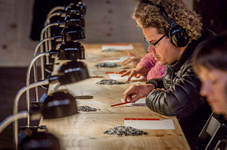 students were instructed to move as slowly as possible while performing their everyday activities. In another exercise, Counting the Rice, students were given piles of uncooked rice mixed with lentils, with an assignment to separate the grains and count them, which usually took several hours [Image at right].
students were instructed to move as slowly as possible while performing their everyday activities. In another exercise, Counting the Rice, students were given piles of uncooked rice mixed with lentils, with an assignment to separate the grains and count them, which usually took several hours [Image at right]. Brazil in 2012/2013. One of the most important teachers Abramović met there was
Brazil in 2012/2013. One of the most important teachers Abramović met there was  supposedly generating the mysterious “current” through their contacts with the audience, as it was announced in the catalogue of the performance (O’Brien 2014:16). Abramović and her assistants gently whispered to every visitor to close their eyes, and to “be in the present,” while they were leading them by the hand in the gallery and instructing them what to do next Abramović and her assistants also laid their hands “reiki-like” on the visitors’ backs [Image at right], as if they were manipulating some kind of “energy.” The activities at the exhibition were not the same during the sixty-four days, as Abramović experimented to find out which of the exercises produced more “energy” there. Some of these exercises were later incorporated in new versions of The Abramović Method presented in São Paolo (2015), Sydney (2015), and Athens (2016). In these new versions of her Method, Abramović also introduced some of the exercises from the Cleaning the House student workshop mentioned before.
supposedly generating the mysterious “current” through their contacts with the audience, as it was announced in the catalogue of the performance (O’Brien 2014:16). Abramović and her assistants gently whispered to every visitor to close their eyes, and to “be in the present,” while they were leading them by the hand in the gallery and instructing them what to do next Abramović and her assistants also laid their hands “reiki-like” on the visitors’ backs [Image at right], as if they were manipulating some kind of “energy.” The activities at the exhibition were not the same during the sixty-four days, as Abramović experimented to find out which of the exercises produced more “energy” there. Some of these exercises were later incorporated in new versions of The Abramović Method presented in São Paolo (2015), Sydney (2015), and Athens (2016). In these new versions of her Method, Abramović also introduced some of the exercises from the Cleaning the House student workshop mentioned before.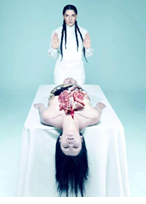 Gaga, and that she danced with rapper Jay Z, both of whom are believed by conspiracy theorists to be involved with the secret world government of the “Illuminati,” only added fuel to the fire. It should be added that Abramović had indeed been playing with magic and perhaps Satanist symbols during an eccentric photo-shoot for the Ukrainian edition of Vogue in 2014. [Image at right] One photo shows her holding a goat head, represented also in the Sigil of Baphomet, whose origins in the system of magic of Éliphas Lévi (1810-1875) were not Satanic but that later was also used as an official symbol of the Church of Satan. Another photo shows her standing behind “butchered” female bodies, as a kind of a sinister priestess. However, there is no evidence that Abramović is in fact a Satanist. According to Massimo Introvigne, “one needs to worship the character called the Devil or Satan in the Bible” to be defined as a Satanist. Abramović has no intentions whatsoever to worship Satan, but simply uses certain symbols that have been used by Satanists as well as by other non-Satanist occult groups, in a different context and often “in a rather playful way” (Introvigne 2016).
Gaga, and that she danced with rapper Jay Z, both of whom are believed by conspiracy theorists to be involved with the secret world government of the “Illuminati,” only added fuel to the fire. It should be added that Abramović had indeed been playing with magic and perhaps Satanist symbols during an eccentric photo-shoot for the Ukrainian edition of Vogue in 2014. [Image at right] One photo shows her holding a goat head, represented also in the Sigil of Baphomet, whose origins in the system of magic of Éliphas Lévi (1810-1875) were not Satanic but that later was also used as an official symbol of the Church of Satan. Another photo shows her standing behind “butchered” female bodies, as a kind of a sinister priestess. However, there is no evidence that Abramović is in fact a Satanist. According to Massimo Introvigne, “one needs to worship the character called the Devil or Satan in the Bible” to be defined as a Satanist. Abramović has no intentions whatsoever to worship Satan, but simply uses certain symbols that have been used by Satanists as well as by other non-Satanist occult groups, in a different context and often “in a rather playful way” (Introvigne 2016).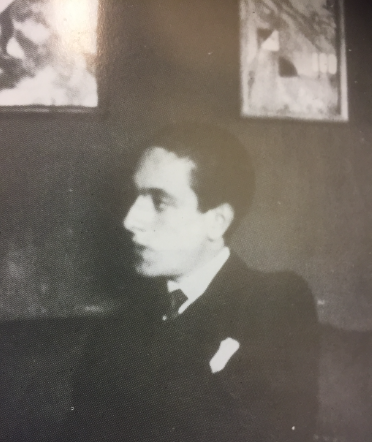
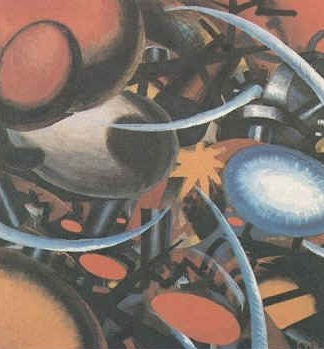
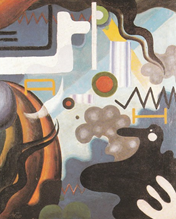
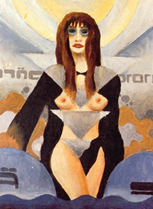
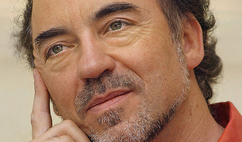
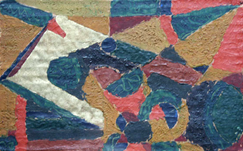
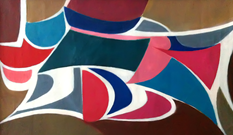
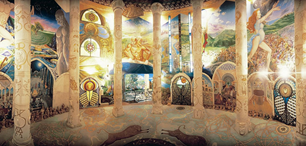
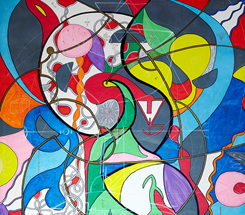
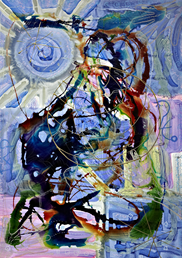
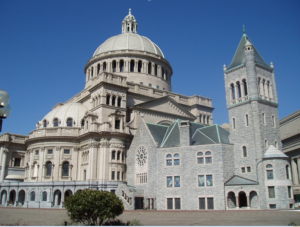
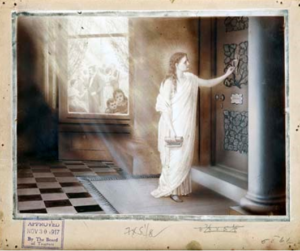
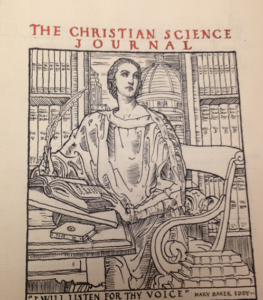
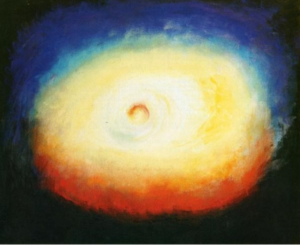 1935. The title of her most well-known non-figurative work, Quarante Huit Quai d’Auteuil, refers to her address in Paris, where she started a lifelong friendship with Dutch abstract painter Piet Mondrian (1872-1944). From the abstract experiments, however, Nicholson consistently returned to flowers. Later in life, she formed a close association with Chinese abstract painter Li Yuan-Chia (1929-1994). Under his influence, she experimented with prisms, producing a whole series of painted meditations about light, a symbol of Christ and of Divine Science dispelling the errors of the mortal mind. [Image at right]
1935. The title of her most well-known non-figurative work, Quarante Huit Quai d’Auteuil, refers to her address in Paris, where she started a lifelong friendship with Dutch abstract painter Piet Mondrian (1872-1944). From the abstract experiments, however, Nicholson consistently returned to flowers. Later in life, she formed a close association with Chinese abstract painter Li Yuan-Chia (1929-1994). Under his influence, she experimented with prisms, producing a whole series of painted meditations about light, a symbol of Christ and of Divine Science dispelling the errors of the mortal mind. [Image at right]